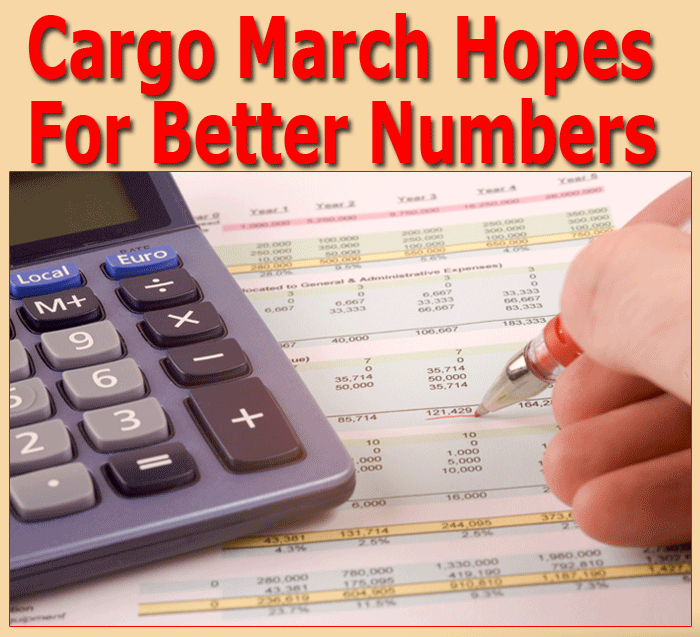
A disappointing Chinese New Year has been
followed by weak demand on the major lanes out of Asia, exacerbated
by the disruptive currents emanating from the U.S.-China trade war and
uncertainty over ongoing negotiations.
Most industry experts now don’t expect
a jump in volumes and/or pricing rebound to materialize until the second
half of 2019.
TAC Index Mixed
The latest TAC Index readings reveal that
Hong Kong-North America lanes dipped from a peak of $5.69 per kg on November
19, 2018 to $3.42 per kg on March 4. Hong Kong-Europe routes, meanwhile,
peaked at $3.77 per kg on December 10 before slumping to $2.35 on February
18 and then recovering marginally to $2.57 per kg on March 4.
ACD Volume
Drop
The latest monthly volumes studied by analysts
at World ACD confirm how pricing is reacting to demand. “The first
month of 2019 confirmed the trend we have seen for a number of months
now: another volume drop, this time of 2% year-on-year, coupled with a
yield drop in USD of 2.5%,” said the analyst.
WorldACD also noted that Chinese New Year
had a counter intuitive impact on flows to and from China. “Origin
China grew by 5% year-on-year in January, but the destination China fell
by more than 10%,” it noted. “We observed this trend also
in the past two months, but it was more pronounced in January due to the
early Chinese New Year, Feb 5 in 2019. As we see it, the period preceding
this day seems to have had a small positive effect on outgoing business
from Asia Pacific, but a more serious negative effect on incoming business.”
The Sulphur
Factor
 With
the China-U.S. trade war still weighing heavily on demand and clouding
the forward outlook, and demand from Europe tepid, most executives contacted
by Flying Typers said there was little reason to expect a market
rebound in the coming months. With
the China-U.S. trade war still weighing heavily on demand and clouding
the forward outlook, and demand from Europe tepid, most executives contacted
by Flying Typers said there was little reason to expect a market
rebound in the coming months.
“January 1, 2020 implementation of
IMO low sulphur fuel rules may shift some cargo from ocean to air later
in the year and could impact capacity and rates,” said Cathy Morrow
Roberson, founder and head analyst at Logistics Trends & Insights.
“In addition, inventory replenishment
will be necessary, particularly after stockpiling occurred ahead of anticipated
tariffs on Chinese goods in 2018 and early 2019. Otherwise, addressing
growing e-commerce volumes will be needed for the air cargo market particularly
for faster delivery times for delivery as well as for returns processing.”
Fluid Markets
Flexport
Neel Jones Shah, SVP and Global Head of
Air Freight at Flexport, told FlyingTypers that the outlook for
the key Transpacific lane was extremely fluid following the suspension
by President Trump earlier this month of planned new tariffs on imports
from China.
“There are a lot of moving parts so
it’s hard to be incredibly definitive about 2019,” he said.
“It has been an extremely slow year out of China whether it’s
mainland or Hong Kong. And the recovery from CNY has been one of the slowest
that I’ve ever experienced in my 17 years in the business. It’s
just been a very, very slow recovery from Chinese New Year, and volumes
are down, and you clearly see that in the statistics.
“That being said, there are other
parts of Asia that are doing extremely well. In North Asia, for example,
Japan is very strong. Automotive traffic to the U.S. is vibrant. South
East Asia has also been quite active—Vietnam, Thailand, Malaysia.
“All of this could be due to the shift
in production (due to U.S, tariffs on Chinese exports) from China into
South East Asia.
“I think that as you look at the balance
of the year, I am extremely optimistic as I think most people are now,
that the U.S. and China are going to solve their trade dispute, and may
even roll back the 10% tariff. And if they do that, clearly Chinese exports
are going to become extremely competitive once again.”
Trade War
Modal Shift & Volumes
 Freightos
CMO Eytan Buchman said there had been some modal shift to ocean so far
this year while the U.S.-China trade war was also limiting Transpac volumes. Freightos
CMO Eytan Buchman said there had been some modal shift to ocean so far
this year while the U.S.-China trade war was also limiting Transpac volumes.
“The China trade tariffs stimulated
advance shipping and we suspect that the protracted threat encouraged
some U.S. importers to explore cheaper, slower ocean freight,” he
said. “The latest WTO first quarter international trade indicator
was the weakest since early 2010. There are steep declines in the indices
for export orders and international air freight.
“China-Europe rail connections are
a small but growing competitive threat to air freight in the long term.”
And, he added, “a hard Brexit may
stimulate demand short term, but with the UK economy likely to contract,
this won’t last.”
Looking for positives, he said as 2019 rolled
out the continued growth of ecommerce would generate greater demand for
more smaller shipments.
“IMO low-sulfur fuel regulations will
also increase ocean freight rates toward the end of the year, encouraging
some importers to switch back to air freight,” he added.
SkyKing
|




 Vol.
18 No. 16
Vol.
18 No. 16